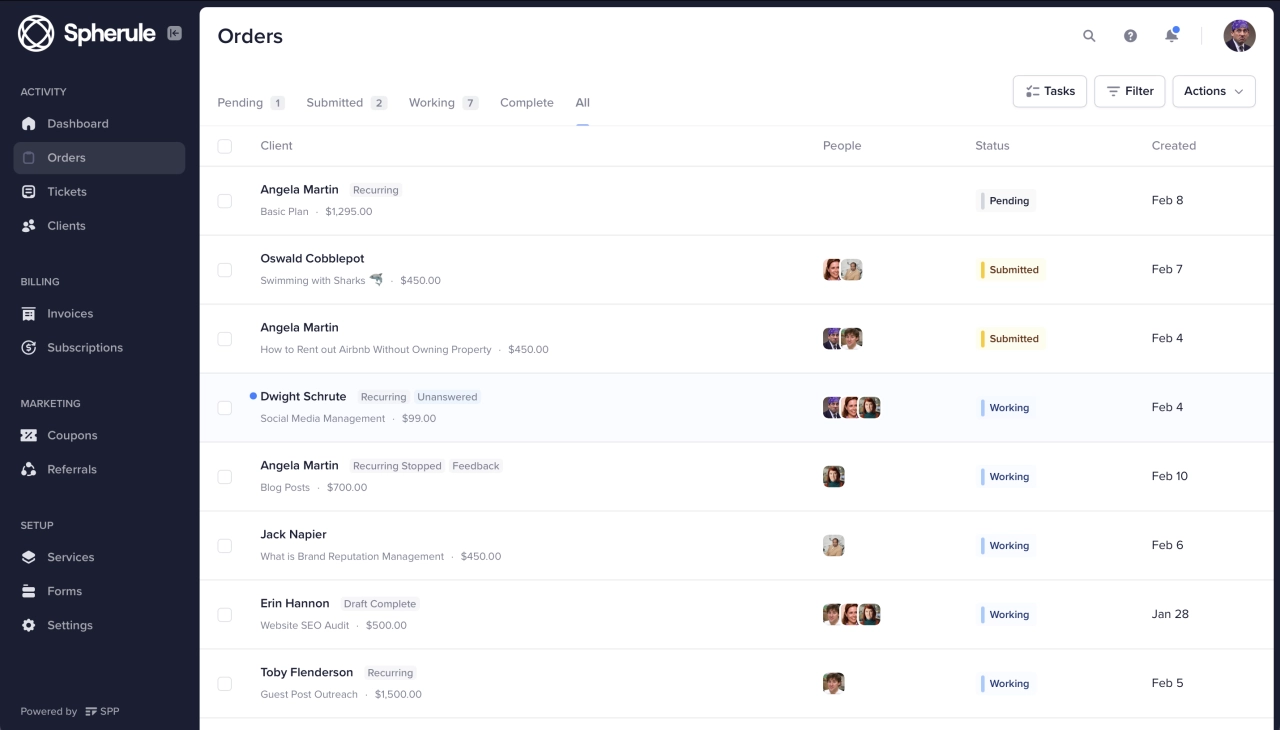Simple CLV Calculator for productized Agencies
Determine the long-term value of subscription clients in your productized agency model.
Results
Lifetime Revenue
$12,000
Lifetime Profit
$4,800
ROI on Acquisition
140%
Key Insights
- Each client brings in $12,000 total revenue over their lifetime.
- After costs, you profit $4,800 per client.
- You get 140% return on your acquisition investment.
- Break-even occurs after 5 months.
Frequently Asked Questions
- What does the Simple CLV Calculator do?
-
The Simple CLV Calculator helps productized agencies determine the long-term financial value of their subscription clients. It calculates the total revenue and profit a client generates over their entire relationship with your agency, factoring in recurring revenue, delivery costs, and client acquisition investment.
By understanding your true client lifetime value, you can make more informed decisions about marketing spend, pricing, and client retention strategies.
- Who should use this calculator?
-
This calculator is designed for owners, financial managers, and marketing directors of productized service agencies using subscription-based pricing models.
- Agencies evaluating their profitability per client
- Marketing teams determining affordable client acquisition costs
- Agency owners making pricing decisions
- Sales teams justifying longer contract commitments
- Investors or buyers evaluating agency business models
- Why is client lifetime value (CLV) important for agencies?
-
Understanding CLV transforms how you view your business in several ways:
- It shifts focus from monthly revenue to long-term client relationships
- It reveals the true ROI of your acquisition efforts
- It helps you identify which types of clients are most profitable
- It informs your pricing strategy and package structure
- It quantifies the financial impact of improving retention
- It allows for more accurate business valuation and forecasting
- What inputs do I need to provide for accurate results?
-
The calculator requires four key inputs:
- Package Price : Your monthly recurring fee for the service package
- Average Retention : How many months clients typically stay with your agency
- Monthly Delivery Cost : Direct costs to deliver your service each month
- Client Acquisition Cost : Total investment to acquire a new client
For the most accurate results, use actual historical data rather than aspirational targets. If your agency is new, use industry benchmarks as starting points and update as you gather real data.
- What does "Lifetime Revenue" tell me?
-
Lifetime Revenue represents the total income generated from an average client throughout their entire relationship with your agency. It's calculated by multiplying your monthly package price by your average retention period.
This figure gives you the "top line" view of a client's value before accounting for any costs, helping you understand the potential revenue generated from a typical client relationship.
- How should I interpret "Lifetime Profit"?
-
Lifetime Profit shows the total net profit generated from an average client after subtracting both ongoing delivery costs and the one-time acquisition cost. This is your true bottom-line value per client and represents the actual financial contribution each client makes to your business over their lifetime.
A negative Lifetime Profit indicates an unsustainable business model requiring adjustment to pricing, delivery costs, or retention strategies.
- What's a good ROI on acquisition?
-
ROI on acquisition varies by industry, but generally:
- Below 0% : Unprofitable; immediate action required
- 0-100% : Questionable; review pricing and costs
- 100-200% : Acceptable; room for improvement
- 200-300% : Good; sustainable business model
- 300%+ : Excellent; potential to scale acquisition
Most successful productized agencies target at least 200% ROI on acquisition, meaning they earn back their acquisition investment plus twice that amount in profit over the client's lifetime.
- What does the break-even point indicate?
-
The break-even point shows how many months it takes to recover your client acquisition cost. It represents when a client begins generating real profit for your agency.
- 1-2 months : Exceptional (rare in agency models)
- 3-4 months : Excellent
- 5-6 months : Good
- 7-9 months : Acceptable
- 10+ months : Concerning; high risk if clients don't stay long enough
If your break-even point is close to or exceeds your average retention, your business model needs adjustment as you're losing money on many clients before they become profitable.
- How can I use CLV to determine my maximum allowable CAC?
-
To determine how much you can afford to spend acquiring a new client:
- Calculate your CLV using the calculator
- Determine your target ROI on acquisition (e.g., 200%)
- Divide your Lifetime Profit by (1 + your target ROI)
For example, if your Lifetime Profit is $6,000 and you want a 200% ROI: Maximum Allowable CAC = $6,000 ÷ (1 + 2) = $2,000
This means you can spend up to $2,000 acquiring each client while maintaining your target ROI.
- How can the calculator help me decide between different pricing strategies?
-
The calculator can help you compare different pricing approaches:
- Run calculations with different package prices
- Adjust retention estimates based on how price changes might affect churn
- Consider how delivery costs scale with different package levels
- Compare the resulting lifetime profits and ROIs
This analysis can reveal whether a premium pricing strategy with potentially higher churn might outperform a lower-priced, higher-retention approach. It can also help you determine if offering discounts for longer commitments makes financial sense.
- How does the calculator account for inflation or price increases?
-
The basic calculator assumes a static price throughout the client relationship. In reality, many agencies implement annual price increases.
For a more sophisticated analysis:
- Calculate your average price increase percentage
- Apply a weighted average to your monthly package price input
- Consider using a more advanced financial model for graduated pricing
For example, if you increase prices by 5% annually and average retention is 24 months, you might use a package price approximately 2.5% higher than your initial rate.
- How can I improve the accuracy of my CLV calculation?
-
To refine your CLV calculations over time:
- Track actual client lifespans and update retention figures quarterly
- Segment clients by source, industry, size, or package to calculate distinct CLVs
- Consider calculating median retention alongside average to account for outliers
- Implement cohort analysis to identify trends in retention over time
- Track expansion revenue (upsells/cross-sells) and factor into calculations
- Develop weighted averages for clients with variable spending patterns
The most sophisticated agencies maintain dynamic CLV models that update automatically as new data becomes available.

You're in good company. We've helped agencies like yours sell $500M+ in services.


